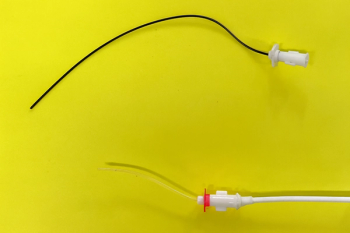
Advanced interpretation of the urine dipstick (Proceedings)
In addition to the CBC and chemistry panel, the urinalysis is the third component of the minimum database. In addition to helping in the evaluation and monitoring of diseases of the kidneys and the lower urinary tract, a urinalysis provides information on the function of a number of other organs.
Indications for performing a urinalysis
In addition to the CBC and chemistry panel, the urinalysis is the third component of the minimum database. In addition to helping in the evaluation and monitoring of diseases of the kidneys and the lower urinary tract, a urinalysis provides information on the function of a number of other organs. In general, a urinalysis should be performed whenever as part of any 'metabolic screen' or 'healthy animal exam,' or when a clinician is investigating any systemic clinical sign or disease. The urinalysis is also be an essential part of monitoring specific diseases or therapies, such as with diabetes mellitus or administration of some antibiotics. Familiarity with how varopis diseases can affect the urinalysis and how to further work-up abnormalities are necessary for a proper appreciation of this diagnostic test.
Urinalysis methodology
The dipstick portion of the urinalysis should be performed within 30 minutes of sample collection, ideally prior to refrigeration. If refrigeration prior to analysis cannot be avoided, urine should be warmed to room temperature and mixed well prior to examination; if urine is opaque or turbid then gently centrifuge the sample as described for preparation of urine sediment examination and test only the supernatant.
Dipsticks are very prone to interference from a variety of chemicals. The pads should never be touched, exposed to room air for extended periods, or allowed to come into contact with moisture. Never use expired strips. Avoid using an excess amount of urine for the dipsticks; excess urine should be removed by tapping the strip on a paper towel or dragging the edge across a clean surface.
Specific gravity
Specific gravity estimates urine osmolarity, which is an indirect measure of renal function. In normal animals specific gravity can vary greatly; this author uses 1.040 in cats and 1.030 in dogs as cut-offs for 'almost 100% guaranteed to be normal.' However, in the absence of any clinical signs (for example, during a routine health exam), lower values can also be acceptable. Conversely, some animals (especially cats with kidney disease or dogs with glomerular disease) may still be able to concentrate their urine despite being in renal failure. When urine is persistently isosthenuric or minimally concentrated (i.e. below 1.020), animals are polyuric even if not reported by the owner. However, some dogs will have urine specific gravities this low due to increased water consumption during times of stress (such as hospitalization or following car rides), and therefore having owners collect a urine sample at home for measurement may be preferred if there is any doubt.
Inability to concentrate urine does not automatically imply renal disease, just as azotemia does not always imply renal failure. In fact, hyposthenuria (specific gravity below 1.008) implies active urine dilution by the kidneys. One tricky situation is the animal that has a non-renal disease that causes minimally to non-concentrated urine, and then is denied access to water or is unable to drink. These animals will rapidly develop pre-renal azotemia because of dehydration, but their urine will remain dilute. In other words, isosthenuria + azotemia in these patients does not equal renal failure. These animals should have rapid resolution of azotemia with fluid administration; hypoadrenocorticism is the classic disease where this combination of findings may occur.
Color is not a reliable method for estimating specific gravity. Hematuria and bilirubin may change urine color without significantly changing specific gravity. Puppies less than 3 weeks of age usually have more dilute urine than dogs 4 weeks of age or older.
Methodology tips: Refractometers are the best balance between cost and accuracy for measuring urine specific gravity. The best refractometers have different scales for dogs and cats; however, if these are not available, the differences are rarely clinically significant. Urine dipsticks are too inaccurate to be clinically reliable for measurement of specific gravity.
The urine dipstick
pH: Urine pH is affected by many variables, including time since the last meal, diet, a number of medications, lung and kidney function, and a renal and systemic diseases. In healthy animals urine pH usually does not require further investigation regardless of the result because alkaline or acid urine can be completely normal. Urine pH should change in response to serum pH. In response to acidic serum, the kidneys will excrete more acid; if the serum is alkaline, the kidneys should excrete more base.
The urine of dogs and cats is usually acidic. However alkaline urine pH may occur a few hours after ingestion of a meal. As the body pumps hydrogen into the stomach for digestion, serum becomes more basic; to compensate, the kidneys therefore excrete bicarbonate (i.e. base), causing a 'post-prandial alkaline tide.' Another cause of alkaline urine is urease-producing bacteria. Some species of Proteus, Staphylococcus, Corynebacterium, and Enterococcus can degrade urea, initiating a cascade of events that results in alkaline urine and possibly struvite urolithiasis. The rarest causes of alkaline urine are the congenital renal tubular acidoses. These diseases include tubular defects that prevent appropriate excretion of acid; in animals with these diseases, urine is alkaline and serum is paradoxically acidic.
Methodology tips: Refrigeration does not affect urine pH. However, unfortunately pH determination by dipstick is inherently error prone—there is significant inter-observer variation, and the dipsticks have an error margin of 0.5-1.5 pH units. Although this is not significant in most cases, it is critical to know exact pH in some animals; the best example is animals being treated for urolithiasis. For these animals a urine pH meter is superior to dipsticks.
Glucose: Glucose is freely filtered by the glomerulus and then reabsorbed by the proximal convoluted tubule. If serum glucose rises above the tubule's capacity to reabsorb the entire filtered glucose load then glucosuria results. This threshold is much higher in cats (approximately 280 mg/dl) than in dogs (approximately 180 mg/dl). Glucosuria means that serum glucose must have been above these levels at some point, or that there is a congenital or acquired tubular disease that prevents full reabsorption of glucose. If glucosuria is present the next step should be paired evaluation of serum and urine glucose. Hyperglycemia, glucosuria, and compatible clinical signs are diagnostic for diabetes mellitus, whereas persistent normoglycemia with glucosuria usually implies the presence of renal tubular disease. Acute or chronic renal failure can lead to glucosuria, although the magnitude seen with chronic renal failure is usually low (trace to 2+). Normoglycemia, glucosuria, and absence of azotemia may be seen with primary renal glucosuria or Fanconi's syndrome; although renal failure may eventually develop with either of these diseases. Cats with stress-induced hyperglycemia may have glucosuria evident on urine dipstick after hyperglycemia has resolved. Urine glucose accumulates during the time of stress, and persists until the cat urinates. Free-catch samples collected by the owner at home prior to transport of the animal to the hospital, or use of indicator crystals that can be mixed in with cat litter at home, may help differentiate diabetes mellitus from stress hyperglycemia.
Methodology tips: Many cleaning products (hydrogen peroxide, bleach, chlorine) can cause false-positives on the glucose dipstick pad; therefore, counter-top and cage-bottom urine samples should not be used. False-negatives may occur with refrigerated samples that are not warmed prior to analysis. The most common urine dipsticks (Multistix®, Diastix®, and Petstix® brands) absorb urine on the glucose pads from the side, not the top. These dipsticks must be dipped in urine or urine must be placed on the side of the pads instead of squirted on top, or false-negatives may occur.
Ketones: Ketones are formed when the body is unable to derive sufficient energy from the metabolism of glucose, and instead must metabolize large quantities of fatty acids. Circulating ketones are easily filtered by the glomerulus, and are reabsorbed in only small quantities. Presence and amount of ketonuria is not affected by kidney disease. Urine dipstick pads can also be used to detect serum ketones. After centrifugation of blood (as with a hematocrit tube) a small amount of serum can be placed on the pad and read with the same technique as urine.
Methodology tips: Abnormally colored urine may cause false-positive results. There are three main ketones—acetone, acetoacetic acid, and β-hydroxybutyrate. Although β-hydroxybutyrate is excreted in the largest amount, urine dipsticks and tablets detect only acetone and acetoacetic acid. Therefore resolution of ketonuria as detected by dipstick may not mean a total absence of ketones, and aggressive treatment of DKA should continue until ketonemia has resolved as well.
Bilirubin: Bilirubin results from the enzymatic degradation of hemoglobin and other heme-containing proteins. Because these enzymes are not present in urine, hematuria does not result in bilirubinuria. Kidney disease does not have any effect on bilirubinuria. Bilirubinuria occurs with hemolysis, liver disease, and cholestasis. Bilirubinuria can develop prior to bilrubinemia.
In dogs the renal tubules can normally conjugate and excrete bilirubin into the urine just as the liver excretes bilirubin into bile. In general, males excrete more bilirubin than females, and intact males excrete more than castrated males. Puppies should have very little to no bilirubin in their urine. Unlike dog kidneys, cat kidneys cannot conjugate bilirubin; therefore bilirubinuria in cats should always be investigated further.
Methodology tips: False-positives can occur whenever urine is discolored, such as with synthetic blood products (Oxyglobin® ), phenazopyridine, rifampin, some sulfa drugs, or with macroscopic hematuria. Bilirubin will spontaneously deconjugate or convert to biliverdin in urine, particularly when left at room temperature or exposed to light. Therefore bilirubin should be assayed soon after urine collection, particularly if not refrigerated. High concentrations of some agents (including chlorhexidine) will interfere with detection of bilirubin.
Urobilinogen: Urobilinogen is formed when intestinal bacteria degrade bilirubin that has been excreted in bile. Some of this urobilinogen is reabsorbed and then excreted in the urine. This compound is important in people, where it may be an early indicator of hemolysis, liver disease, or cholestasis. However, in dogs and cats urobilinogen does not offer any more information than bilirubin. Also, urobilinogen is very unstable and therefore, should not used as a reliable indicator of disease in dogs and cats.
Blood/hemoglobin: Dipsticks will indicate hematuria when red blood cells, hemoglobin, or myoglobin are present; differentiation of these three possibilities is the first step when faced with hematuria. Centrifugation of urine should cause all red blood cells to form a pellet. If the urine supernatant is persistently red or pink, then hemoglobin or myoglobin is present. Hemoglobinuria is often accompanied by a drop in PCV; myoglobinuria usually occurs secondary to severe muscle trauma or necrosis. If myoglobinuria is suspected a serum creatine kinase may help in diagnosis of myopathies; additionally some commercial laboratories can differentiate urine myoglobin from hemoglobin. If red blood cells are present, measuring the PCV of the urine (in addition to the serum) can help with diagnostic and therapeutic decisions.
A common cause of hematuria is iatrogenic introduction during cystocentesis. However, this usually results in minor bleeding, and red blood cells are rarely greater than 10-20/hpf on sediment examination; hemoglobinuria should not be present. Microscopic hematuria can occur with disease anywhere in the urogenital tract. To help localize the origin of hematuria, and another way to determine whether hematuria is iatrogenic or not, is to collect a free catch prior to a cystocentesis sample, and to compare the results of urinalyses. Hematuria in a free-catch sample that is not present on a cystocentesis sample implies bleeding distal to the bladder.
Hemoglobinuria can result from lysis of red blood cells in dilute or alkaline urine. Alternatively hemoglobin can enter the urine from the bloodstream following intravascular hemolysis. Common causes include immune-mediated hemolysis, zinc toxicity, and methemoglobinemia; hemoglobinuria also occurs with synthetic hemoglobin administration (Oxyglobin®).
Methodology tips: Catheterized samples often contain hematuria secondary to unavoidable trauma to the urethral mucosa. Some brands of urine dipsticks may allow differentiation of red blood cells from hemoglobin or myoglobin pigments by the pattern of color change on the dipstick pad. Homogenous color changes imply the presence of many red blood cells or pigment; spots of color change mean that only a few red blood cells are present, and no pigment is present.
Protein: Dipstick methods for determining urine protein concentration are only semi-quantitative. Because some protein is normally found within urine, a urine protein:creatinine ratio (UPC) must be measured in order to verify if proteinuria is truly pathologically increased. A UPC should be requested when there is any proteinuria and serum albumin is decreased, or when urine protein is greater than expected regardless of serum albumin. Lower specific gravity means that lower protein concentrations may be significant. Normal UPC is less than 0.5 in dogs, and less than 0.4 in cats. Although hematuria can be a cause of proteinuria, the UPC does not become abnormal in dogs unless the urine is grossly discolored (i.e. pink or red).
Proteinuria is due to pre-glomerular, glomerular, or postglomerular disease. With pre-glomerular proteinuria, globulin-producing neoplasms, such as multiple myeloma and some lymphomas and plasma cell tumors, result in excess filtration of immunoglobulin fragments. Other causes of pre-glomerular proteinuria which are documented in people either do not occur (exercise) or are likely not clinically relevant (fever, stress) in dogs and cats. Post-glomerular proteinuria results from any lower urinary tract inflammation, including neoplasia, uroliths, and infections.
Glomerular proteinuria should be investigated once pre- and post-glomerular causes of proteinuria have been eliminated. If a protein-losing nephropathy is present, extra-renal causes of disease should be identified and treated. If no concurrent diseases are diagnosed, or proteinuria persists beyond resolution of any underlying diseases, a renal biopsy is usually indicated.
Methodology tips: Urine dipsticks are much more sensitive to albumin than to other proteins—other causes of proteinuria, particularly pre-glomerular causes, may cause false-negatives. Spinning down urine and testing for proteinuria using only the supernatant may help decrease false-positives caused by cells and debris. Alkaline urine can cause false-positive protein results on urine dipsticks, usually trace to 1+. The sulfosalicylic acid (SSA) test is much more sensitive to non-albumin proteins than standard dipsticks, and is not affected by urine pH.
Nitrite: Some bacteria will produce nitrite, a compound that is not found in large amounts in normal urine. However, the vast majority of bacteria that cause infections in dogs and cats do not increase urine nitrite concentration. Therefore, unlike in people, results of this test are not suitable for detection of urinary tract infections in dogs and cats.
Leukocytes: This dipstick pad detects enzymes found within neutrophils and macrophages. These pads on urine dipsticks have been developed using human leukocytes, not canine or feline cells. To cause a positive reaction these cells must degranulate (as part of an inflammatory response) or lyse (as may occur with hypotonic or alkaline urine), releasing their contents into the urine. Unfortunately, in dogs this test is not sensitive (many false-negatives), while in cats it is not specific at all (many false-positives), likely due to differences between the enzymes in our patients versus in people.
Newsletter
From exam room tips to practice management insights, get trusted veterinary news delivered straight to your inbox—subscribe to dvm360.



